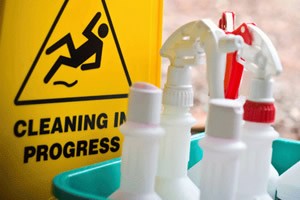 Print a Sign-In Sheet | Spanish Version
Print a Sign-In Sheet | Spanish Version
Employees should be trained in the proper handling, use, and disposal of cleaning chemicals. Mixing cleaning chemicals can produce toxic gases, such as chlorine, nitrogen trichloride, and hydrazine. Dangerous oxygen-free molecules can be released into the lungs. These molecules can be especially hazardous in small areas with little ventilation or air movement, such as bathrooms and closets. When inhaled, these gases may cause lung irritation, sore throat, headaches, breathing difficulty, and when inhaled in large doses, even death. There is seldom a need to mix cleaning products, as there are specialized chemicals and cleaning agents available for nearly every task.
The following guidelines should be followed to help ensure safety:
- Do not mix any cleaning products, especially those containing bleach.
- Train all employees about the dangers of mixing chemicals. Train them in accordance with the Occupational Safety and Health Administration’s (OSHA) Hazard Communication Standard regarding proper reading of Safety Data Sheets (SDS), proper chemical and container labeling, proper disposal of chemicals, proper recognition of exposure symptoms, and proper treatment procedures for exposure.
- If chlorine gas is accidentally released, evacuate the area until there has been sufficient time for ventilation. Do not reopen the area until the gas has been completely removed. If employees are involved in the cleanup of the chemicals, make sure they wear the proper personal protective equipment (PPE) and properly dispose of the chemicals.
- Always run clean water through a drain after flushing or rinsing cleaning products. This will help prevent the formation of toxic gases from chemicals that could potentially mix in the drain pipe.
- When handling chemicals, always follow the prescribed manufacturers’ guidelines and utilize common sense to help protect yourself and others.
KEMI does not assume liability for the content of information contained herein. Safety and health remain your responsibility. This information is to be used for informational purposes only and not intended to be exhaustive or a substitute for proper training, supervision, or manufacturers’ instructions/recommendations. KEMI, by publication of this information, does not assume liability for damage or injury arising from reliance upon it. Compliance with this information is not a guarantee or warranty that you will be in conformity with any laws or regulations nor does it ensure the absolute safety of any person, place, or object, including, but not limited to, you, your occupation, employees, customers, or place of business.

